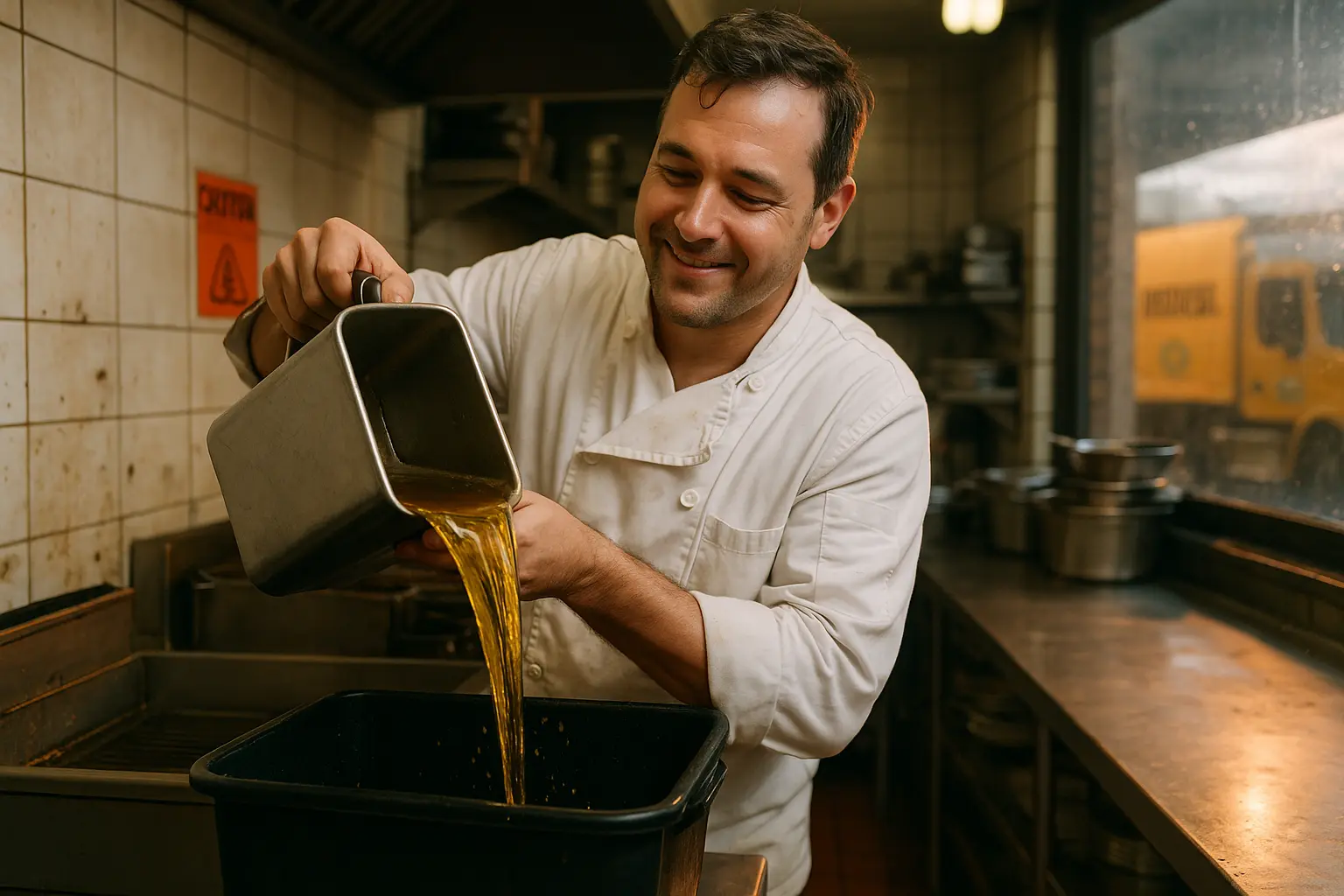Jump to a question:
Do restaurants reuse cooking oil?

Yes, restaurants filter and reuse cooking oil 3-5 times before recycling it, reducing new oil costs by 40% while maintaining food quality through proper filtration.
Commercial kitchens maximize cooking oil value through systematic reuse. Daily filtering removes food particles that degrade oil quality, extending usable life significantly. Most restaurants change fryer oil completely every 3-7 days depending on volume and menu items.
The filtration process determines reuse success. Cool oil below 120°F before filtering to prevent burns and ensure effective particle removal. High-temperature cooking like fried chicken breaks down vegetable oil faster than french fries, affecting reuse cycles.
Smart operators track each batch with dates and usage notes. This prevents mixing old oil with new oil, which accelerates degradation. Once oil darkens permanently or develops off-flavors, it enters the waste cooking oil recycling stream.
⚠️ Oil replacement triggers:
- Dark color persisting after filtration
- Excessive foaming during cooking
- Smoke at normal temperatures
- Food tastes greasy or different
Professional cooking oil collection companies handle disposal through scheduled pickups. They convert used oil into renewable fuel rather than allowing improper disposal that damages sewer systems.
Summary: Restaurants reuse cooking oil 3-5 times through proper filtration before recycling, cutting costs 40% while maintaining quality.

Grease Connections
What do most restaurants use for cooking oil?
Most restaurants use vegetable oil blends (75%), canola oil (15%), and soybean oil (10%) for their high smoke points, neutral flavors, and value as yellow grease in recycling markets.
Vegetable oil blends dominate commercial kitchens due to versatility across different cooking methods. These oils maintain stability at high temperatures through multiple uses before requiring disposal. The 400-450°F smoke point range suits most restaurant cooking needs.
Canola oil gains market share in health-conscious establishments. Lower saturated fat content appeals to customers while the 425°F smoke point handles demanding kitchen operations. All these oils qualify as valuable yellow grease for biodiesel production.
Oil selection impacts both cooking results and recycling revenue. Clean used vegetable oil commands premium prices from companies like Mahoney Environmental because it efficiently converts to biodiesel. Mixed or contaminated oils receive significantly lower rebate payments.
📊 Restaurant oil breakdown:
- Vegetable blend: $8-12/gallon, 400°F smoke point
- Canola: $10-14/gallon, 425°F smoke point
- Soybean: $7-10/gallon, 450°F smoke point
- Peanut: $15-20/gallon, 450°F smoke point
Many restaurants reduce costs through recycling rebates that offset 20-30% of new oil expenses. Proper oil disposal becomes a profit center rather than waste management burden.
Summary: Vegetable oil blends lead at 75% usage for versatility and recycling value as premium yellow grease.
What happens to restaurant cooking oil?

Used cooking oil gets collected by recycling companies and converted into biodiesel fuel through transesterification, reducing greenhouse gas emissions by 85% compared to petroleum diesel.
The recycling journey starts when cooking oil pickup trucks arrive on regular schedules. Professional oil collection services pump waste oil from storage containers while documenting volumes for rebate calculations. This prevents illegal drain disposal causing sewer blockages.
Biodiesel production transforms restaurant grease through chemical processes. Used oil undergoes transesterification—mixing with methanol and catalysts to create renewable fuel. The resulting biodiesel biodegrades five times faster than fossil fuels while powering vehicles nationwide.
Cities mandate proper cooking oil disposal through strict regulations. Restaurants must partner with reliable companies to avoid environmental violations. Improper disposal methods like pouring oil down drains trigger sanitary sewer overflows costing thousands in fines.
🔄 Oil recycling pathway:
- Restaurant collects used oil in designated containers
- Licensed companies provide cooking oil pickup service
- Processing facilities filter contaminants
- Transesterification converts oil to biodiesel
- Fuel distributed for transportation use
- Byproducts become animal feed ingredients
Regular grease trap maintenance complements oil recycling programs. Grease interceptor systems prevent fats from entering municipal sewers. Combined management protects infrastructure while generating revenue.
Summary: Restaurant oil becomes biodiesel through professional recycling, cutting emissions 85% while preventing costly sewer damage.

Grease Connections
Can you get paid for used cooking oil?

Yes, restaurants earn $0.10-$0.65 per gallon selling used cooking oil to collection companies, with rates based on volume, quality, and current yellow grease market prices.
Oil collection companies compete for restaurant partnerships because biodiesel demand drives strong pricing. Local businesses producing over 100 gallons monthly qualify for rebate programs. Many restaurants offset entire grease disposal budgets through oil revenue.
Payment structures accommodate different business preferences. Some companies offer cash payments while others provide credits against grease trap installation or maintenance services. Maintaining oil quality proves critical—water contamination cuts values significantly.
Volume commitments unlock premium rates. Restaurants producing 500+ gallons monthly negotiate top-tier pricing. Consolidating multiple locations under one contract increases bargaining power for better per-gallon rates.
💰 Rebate structure by volume:
- Under 100 gallons: Free pickup only
- 100-300 gallons: $0.10-$0.25/gallon
- 300-500 gallons: $0.25-$0.40/gallon
- Over 500 gallons: $0.40-$0.65/gallon
Proper storage maximizes oil value. Covered containers prevent rain dilution while dedicated storage areas maintain quality. Using drain screens and absorbing spills with paper towels keeps oil contamination-free for top dollar.
Summary: Quality used cooking oil generates $0.10-$0.65 per gallon in rebates, with high-volume producers earning enough to cover all disposal costs.

Grease Connections
Complete Guide Summary
Restaurant used cooking oil management transforms environmental liabilities into profitable revenue streams through systematic recycling. Commercial kitchens extend oil life 3-5 times via proper filtration, reducing costs 40% before sending waste cooking oil to biodiesel production. Most establishments use versatile vegetable oil blends that perform reliably at high temperatures while qualifying as valuable yellow grease.
Professional cooking oil disposal prevents business-destroying consequences from improper practices. Drain disposal causes severe plumbing issues and triggers environmental fines up to $50,000. Instead, scheduled collection services ensure safe removal while paying rebates reaching $0.65/gallon for quality oil. The recycling process converts grease into renewable fuel through transesterification, creating biodiesel that reduces greenhouse gas emissions 85% versus petroleum diesel.
Effective programs include comprehensive grease management beyond just fryer oil. Regular grease trap maintenance prevents accumulation in sanitary sewer systems. Installing drain screens catches food particles while proper spill cleanup keeps grease from drains. These practices create safer work environments while protecting municipal infrastructure from blockages authorities trace to source restaurants. Combined with oil recycling revenue, smart grease management becomes a profit center supporting both business success and environmental responsibility.









